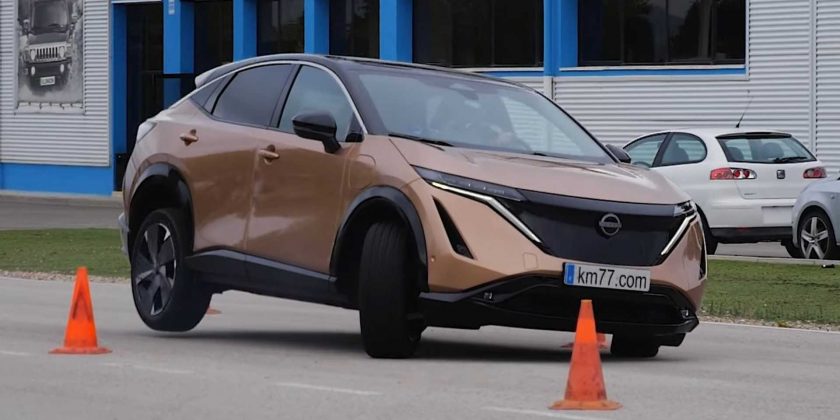The Nissan Ariya, after securing a 5-star safety rating from Euro NCAP, shines also in the “moose test.”
The tested version was equipped with a 66 kWh battery (63 kWh usable), front-wheel drive, and optional 20″ wheels (Michelin Primacy 4 255/45 R20 101V). In other words, it’s the lightest version with pretty good tires.
According to km77.com, the Nissan Ariya was able to successfully pass the test with an initial speed of 77 km/h (48 mph), which only a handful of BEVs can beat. The reactions of the car during the moose test were described as neutral, safe, and easy to control.
- initial part: 77 km/h (48 mph)
- middle part: 62 km/h (39 mph)
- final part: 30 km/h (19 mph)
This result is better than in the case of the Renault Megane E-Tech – 74 km/h (46 mph) – based on the same Renault-Nissan-Mitsubishi Alliance’s CMF-EV platform. The French compact EV actually had a chance to achieve a result of up to 77 km/h, but its reactions happened to be inconsistent, according to km77.com.
km77.com’s moose test results for reference (initial speed):
- 2019 Tesla Model 3 LR AWD – 83 km/h (52 mph)
- 2021 Tesla Model Y LR AWD – 83 km/h (52 mph)
- 2021 Hyundai Ioniq 5 (RWD, 72.6 kWh) – 82 km/h (51 mph)
- 2018 BMW i3s – 79 km/h (49 mph)
- 2021 MINI Countryman SE (PHEV) – 79 km/h (49 mph)
- 2021 Aiways U5 – 78 km/h (48 mph)
- 2021 Kia EV6 (RWD, 77.4 kWh) – 78 km/h (48 mph)
- 2020 Porsche Taycan Turbo S – 78 km/h (48 mph)
- 2021 Porsche Taycan Turbo S Cross Turismo – 78 km/h (48 mph)
- 2019 Audi e-tron – 77 km/h (48 mph)
- 2021 Dacia Spring – 77 km/h (48 mph)
- 2020 MINI Cooper SE – 77 km/h (48 mph)
- 2022 Nissan Ariya (66 kWh, FWD) – 77 km/h (48 mph)
- 2021 Peugeot e-2008 – 77 km/h (48 mph)
- 2020 Renault Twingo Z.E. – 77 km/h (48 mph)
- 2020 Peugeot e-208 – 76 km/h (47 mph)
- 2021 Audi e-tron GT – 75 km/h (47 mph)
- 2020 Audi e-tron Sportback – 75 km/h (47 mph)
- 2021 Cupra Born (RWD, 62 kWh) – 75 km/h (47 mph)
- 2021 Fiat 500 electric – 75 km/h (47 mph)
- 2020 Honda e – 75 km/h (47 mph)
- 2020 Opel Corsa-e – 75 km/h (47 mph)
- 2022 BMW iX xDrive40 – 74 km/h (46 mph)
- 2021 Citroën ë-C4 – 74 km/h (46 mph)
- 2018 Hyundai Kona Electric – 74 km/h (46 mph)
- 2020 Mazda MX-30 – 74 km/h (46 mph)
- 2022 Polestar 2 (AWD, 78 kWh) – 74 km/h (46 mph)
- 2022 Renault Megane E-Tech – 74 km/h (46 mph)
- 2022 BMW i4 eDrive40 – 73 km/h (45 mph)
- 2018 Jaguar I-PACE – 73 km/h (45 mph)
- 2022 Mercedes-Benz C 300 e – 73 km/h (45 mph)
- 2021 Volkswagen ID.4 – 73 km/h (45 mph)
- 2022 Mercedes-Benz EQS 580 – 72 km/h (45 mph)
- 2021 Jaguar F-Pace PHEV – 71 km/h (44 mph)
- 2020 Jeep Renegade 4xe – 70 km/h (44 mph)
- 2019 SEAT Mii Electric – 70 km/h (44 mph)
- 2016 Tesla Model X – 70 km/h (44 mph)
- 2022 Volvo C40 Recharge – 70 km/h (44 mph)
- 2019 Ford Kuga PHEV (Ford Escape PHEV in the US) – 68 km/h (42 mph)
- 2019 Kia Soul EV (e-Soul) – 68 km/h (42 mph)
- 2021 Skoda Enyaq iV – 67 km/h (42 mph)
In the second part of the video – the slalom test – the Nissan Ariya achieved a time of 25.5 seconds. That’s not fast, but let’s not forget that it’s the entry-level version of the car.
Previous results for reference:
- 2022 Polestar 2 (AWD, 78 kWh) – 22.8 s
- 2021 Cupra Born (RWD, 62 kWh) – 23.6 s
- 2022 BMW i4 eDrive40 – 24.0 s
- 2022 Renault Megane E-Tech – 24.2 s
- 2022 Volvo C40 Recharge – 24.4 s
- 2022 Mercedes-Benz EQS 580 – 24.5 s
- 2021 Aiways U5 – 24.7 s
- 2022 BMW iX xDrive40 – 24.8 s
- 2021 Peugeot e-2008 – 25.3 s
- 2022 Nissan Ariya (66 kWh, FWD) – 25.5 s
- 2021 Dacia Spring – 27.9 s
- Share on Facebook
- Share on Twitter
- Share on LinkedIn
- Share on Flipboard
- Share on Reddit
- Share on WhatsApp
- Send to email
Source: Read Full Article

